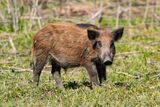Now Reading: Neon Blue Wild Pigs in California Alarm Authorities: Public Advised to Avoid Contact
-
01
Neon Blue Wild Pigs in California Alarm Authorities: Public Advised to Avoid Contact
Neon Blue Wild Pigs in California Alarm Authorities: Public Advised to Avoid Contact

Quick Summary
- wild pigs in Monterey County, California, are turning bright blue due to ingestion of the rodenticide diphacinone.
- The California Department of Fish and Wildlife (CDFW) has advised hunters to avoid consuming meat from animals that show abnormal features like blue-colored muscle or fat.
- Diphacinone is an anticoagulant poison dyed for visibility when applied as bait for rodents, but non-target wildlife like pigs can ingest it directly or indirectly via contaminated prey.
- A 2018 USDA study found meaningful rodenticide contamination in game animals such as wild pigs and bears in agricultural/residential areas of California.
- Hunters are encouraged to report abnormalities and refrain from consuming suspicious game, while applicators must take precautions to prevent unintended exposure to non-target animals.
indian Opinion Analysis
The emergence of brightly colored wild pigs highlights concerns over pesticide use affecting ecosystems beyond their target species-a worldwide issue that transcends geographical boundaries.While this incident is specific to California, India’s practices with chemicals used in agriculture may face similar risks for wildlife contamination given it’s vast biodiversity and reliance on pesticides. Monitoring residues in hunted or consumed game could ensure food safety while protecting non-target species crucial for ecosystem balance. Lastly, awareness campaigns among hunters and applicators could minimize environmental harm globally by emphasizing safer practices.
























